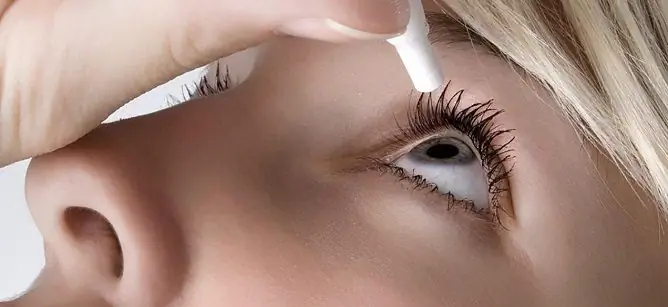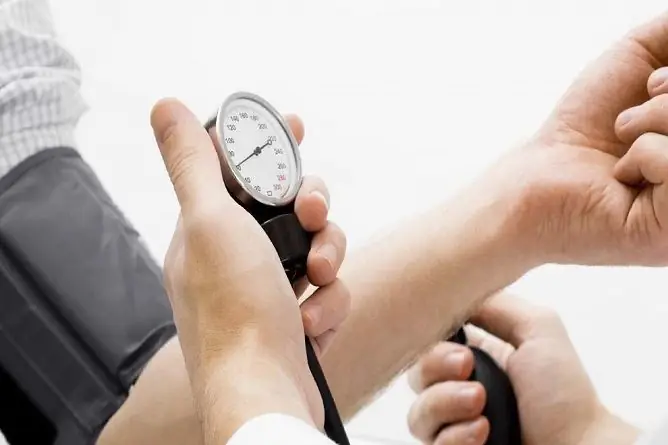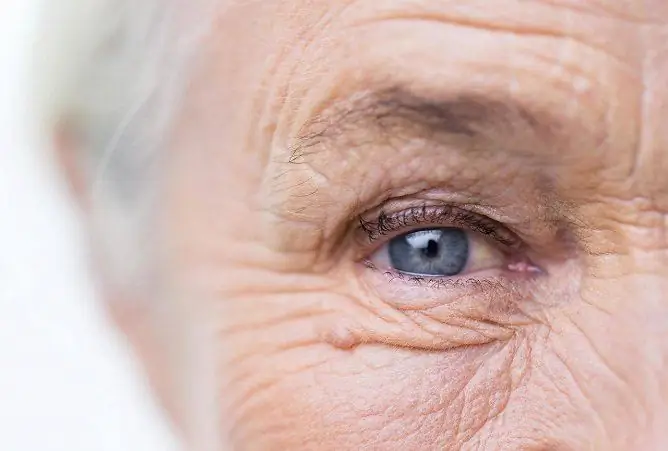- Author Rachel Wainwright [email protected].
- Public 2023-12-15 07:39.
- Last modified 2025-11-02 20:14.
Eye drops for eye pressure and glaucoma
The content of the article:
-
List of eye drops for eye pressure
- Beta-blockers
- Cholinomimetics
- Carbonic anhydrase inhibitors
- Prostaglandin analogs
- Sympathomimetics
- Combined drugs
- About intraocular pressure
- Glaucoma
- Video
Drops from eye pressure help to reduce the production of intraocular fluid or increase its outflow, and some of them have both of these properties. The use of such drops is the main method for normalizing intraocular pressure.

The use of eye drops is the main method of treating increased intraocular pressure
A persistently high intraocular pressure is called glaucoma. The disease is dangerous in the long term - if the pressure is not reduced, retinal detachment and atrophy of the optic nerve will begin. This leads to irreversible deterioration of vision, up to complete blindness. What if such a diagnosis is made?
List of eye drops for eye pressure
What pharmacological agents are used in practice? There are three main mechanisms of action of drugs that reduce high intraocular pressure - some affect the formation of fluid, others normalize its circulation and utilization, and still others combine these two principles. Based on this, several groups of drugs are used to combat increased eye pressure.
Beta-blockers
The best medicines with practically no side effects, which are prescribed primarily in the treatment of increased intraocular pressure. After instilling a sore eye, it is recommended not to open it for several minutes, so that the blocker does not get through the nasolacrimal canal onto the mucous membrane, thereby preventing its systemic action. Locally, these eye drops for glaucoma and ocular pressure decrease the production of ocular moisture. Can they raise blood pressure? With systemic exposure, drugs such as Arutimol, Okumed, Timoptic can cause an increase in heart rate, but this effect is almost completely eliminated in Timolol and Betoptik. They also increase the outflow of moisture, and Betoptic has no effect on the pupil, so it does not impair vision. Beta-blockers are contraindicated in childrenpeople with heart failure, bronchial obstruction should not drip them if the cornea is damaged.

Timolol - eye drops from the group of beta-blockers
Cholinomimetics
Drugs that act on m-cholinergic receptors, causing a significant improvement in fluid circulation within the eye. These drops for lowering eye pressure lead to constriction of the pupils, open the corner of the anterior chamber of the eye, from where the fluid easily flows out, and thereby relieve the hypertensive state. This group includes drugs such as Pilocarpine and Carbacholine. They are effective, but they have side effects in the form of classic manifestations of the activation of the parasympathetic nervous system, for example, increased secretion of the glands. Such medicines are not used for bronchial asthma, angina pectoris, keratitis. Cholinomimetics are easy to overdose, so their use should be agreed with your doctor.

Pilocarpine - a drug from the group of cholinomimetics
Carbonic anhydrase inhibitors
They reduce the increased pressure in the eyeball by blocking the enzyme carbonic anhydrase of the ciliary body, thus stopping the transport of sodium ions, which attract water. Treatment consists in reducing the synthesis of intraocular fluid, in particular, moisture in the anterior and posterior chambers of the eye. This group includes Azopt and Trusopt. The first drug is prescribed for patients with open-angle glaucoma, but it should be borne in mind that it is contraindicated for people with acute or chronic kidney disease. The second is used for the treatment of angle-closure glaucoma, it can be used not only in adults, but also in children, the indications are broader than those of the previous remedy.

Azopt drops belong to the group of carbonic anhydrase inhibitors
Prostaglandin analogs
The safest drugs from the point of view of side effects (when used correctly), which increase the permeability of the capillary wall of the membranes of the eye, which significantly improves the outflow of fluid. A decrease in pressure occurs within two hours after instillation, and the therapeutic effect lasts up to 12 hours. Due to its strong action, it is not dispensed without a prescription. This group includes names such as Tafluprost, Latanoprost, Travatan, Lanotan, Ksalatan. These drugs should be dripped into the sore eye once a day, mainly in the evening. Not used until 18 years of age, during pregnancy or lactation, not used to treat congenital glaucoma.

Xalatan is an effective drug, analogue of prostaglandins
Sympathomimetics
Hybrid alpha- and beta-adrenomimetics, at first, briefly increase the amount of intraocular moisture produced, after which they permanently reduce its production.
There is a pronounced stimulation of the sympathetic nervous system, which is manifested by the expansion of the pupil and, due to this, a temporary deterioration in vision. Representatives of this group of drugs are D-Epifrin, Glaucon, Oftan Dipivefrin. They have a long-term therapeutic effect.
Combined drugs
The most effective means for relieving intraocular pressure and relief of manifestations of glaucoma are combined, they contain active substances that are synergistic, that is, their joint effect is enhanced many times as the drugs potentiate each other. These include Fotil, containing pilocarpine and timolol (a classic combination of a cholinomimetic and an adrenergic blocker in ophthalmology), Ksalak (an analogue of prostaglandins xalatan + adrenergic blocker timolol), Kosopt (carbonic anhydrase inhibitor trusopt + adrenergic blocker timolol). These eye pressure drops are the most balanced and effective, they have mostly positive reviews from specialists.

Fotil - a combined preparation for lowering intraocular pressure
Attention! You can not use funds to normalize eye pressure on your own - this can lead to very undesirable consequences, up to loss of vision.
About intraocular pressure
The visual analyzer gives a person most of the entire information flow about the world around him - it accounts for more than 90% of the incoming information. For this reason, eye diseases significantly impair the patient's quality of life. One of these diseases is increased intraocular pressure. A pathological condition can occur for many reasons, acute and chronic.
The pressure inside the eye depends on several factors - it is maintained by the constant circulation of the produced moisture and its excretion. It is a hydrodynamic system in which all components are in delicate equilibrium. Intraocular pressure is normally 12-22 mm Hg. Art. - such a value is necessary to maintain the tone of the eye, its optical properties (shape). If the fluid is produced more than usual or it is less efficiently excreted, the pressure increases - ocular hypertension occurs.
Glaucoma
Chronic increase in intraocular pressure is called glaucoma - in addition to very unpleasant symptoms, this disease can lead to deterioration and loss of vision.
Primary glaucoma develops without an organic substrate and has a dysregulatory mechanism. Many risk factors, including stress, bad habits, myopia, diabetes, age, increase the likelihood of illness. With hypertension, secondary damage to the eyes often develops - it can be keratitis, cataracts, lens shift. There is also a congenital form of glaucoma associated with impaired organogenesis of the eye in the embryonic period.

Glaucoma - a chronic increase in intraocular pressure
The symptoms of glaucoma are usually pronounced - it is characterized by a feeling of distention of the eyeball, narrowing of the visual fields, and a halo around light sources. There is also an acute form, which is manifested by a sudden painful attack - the patient experiences a sharp unbearable pain in the eye. To relieve symptoms and provide a therapeutic effect on the system of synthesis and removal of intraocular fluid, eye drops are usually prescribed to reduce intraocular pressure in glaucoma. However, even if all symptoms indicate glaucoma, you cannot start taking medications on your own - many of them have a wide range of side effects. The doctor prescribes medications for ocular hypertension only after measuring the pressure and examining the fundus.
Video
We offer for viewing a video on the topic of the article.

Nikita Gaidukov About the author
Education: 4th year student of the Faculty of Medicine No. 1, specializing in General Medicine, Vinnitsa National Medical University. N. I. Pirogov.
Work experience: Nurse of the cardiology department of the Tyachiv Regional Hospital No. 1, geneticist / molecular biologist in the Polymerase Chain Reaction Laboratory at VNMU named after N. I. Pirogov.
Found a mistake in the text? Select it and press Ctrl + Enter.






